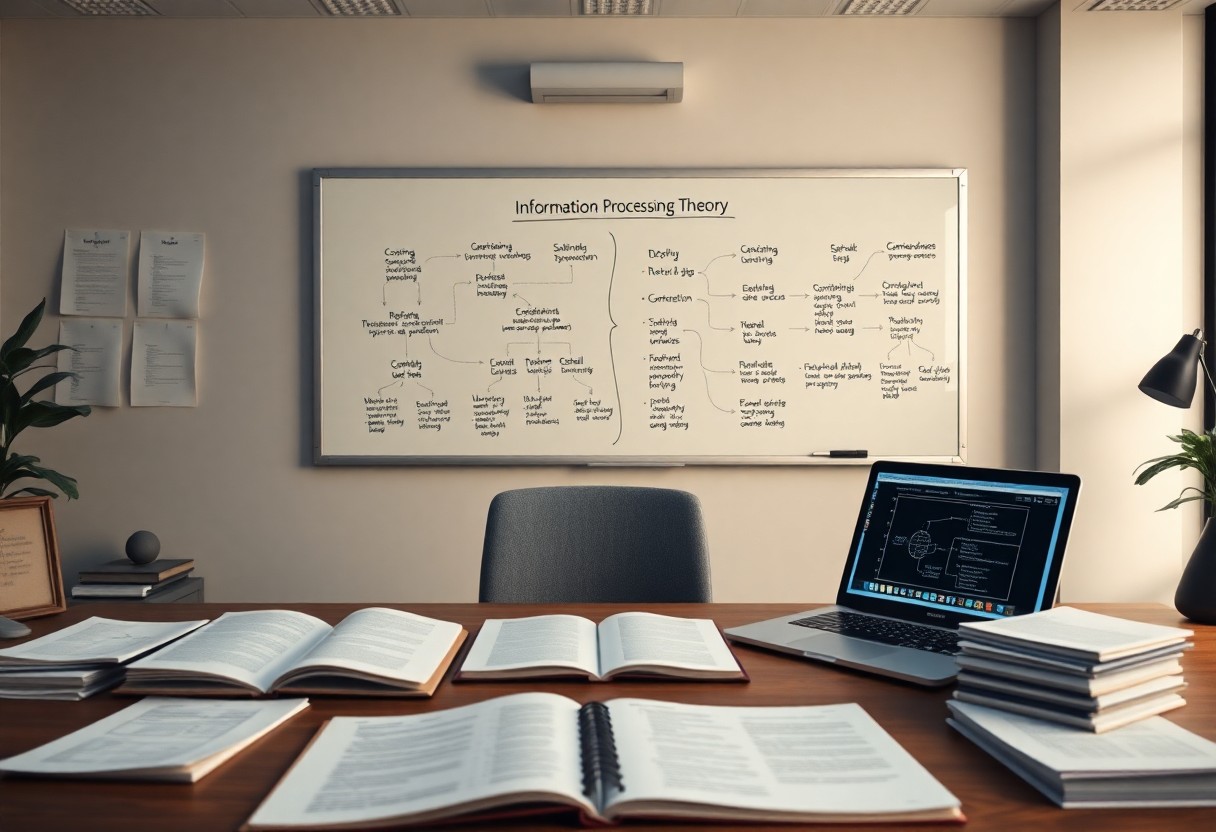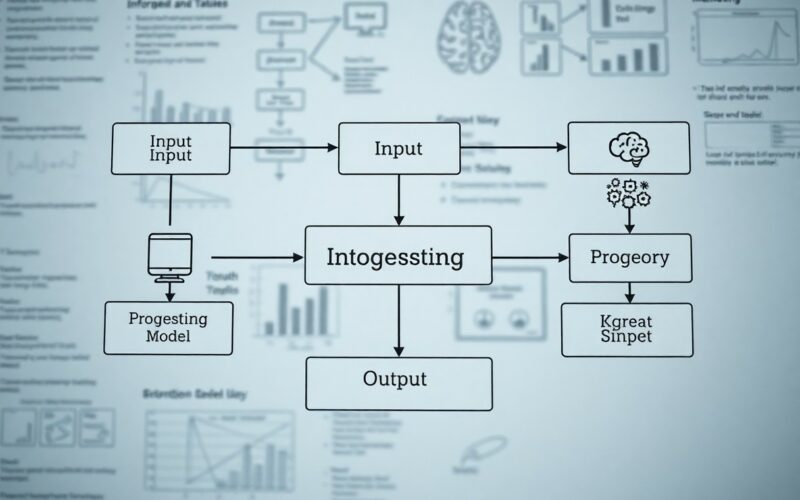You might be surprised to learn that Information Processing Theory offers a fascinating framework for understanding how you take in, process, and store information. This theory breaks down cognitive functions into stages and models, helping you grasp the intricate workings of your mind. Explore the key stages and models that highlight how you learn and retain knowledge, making it easier to apply these insights to enhance your learning strategies and decision-making. Dive in to uncover the important elements that can transform your understanding of cognition!

Key Takeaways:
- Information Processing Theory describes how individuals transform sensory input into knowledge through cognitive processes.
- Key stages include encoding, storage, and retrieval, which reflect how information is managed and utilized.
- Models like the Atkinson-Shiffrin model illustrate the flow of information across sensory memory, short-term memory, and long-term memory.

The Origins of Information Processing Theory
The emergence of Information Processing Theory can be traced back to the mid-20th century as scholars began to view the mind akin to a computer. This analogy allowed researchers to explore how information is encoded, stored, and retrieved. Pioneering researchers such as Noam Chomsky and George A. Miller laid the groundwork, challenging behaviorist views and emphasizing cognitive processes.
Historical Context and Key Influencers
In the 1950s and 1960s, the introduction of computers profoundly influenced psychology. Cognitive scientists began to investigate mental processes, with key figures like Ulric Neisser defining cognitive psychology’s scope. Neisser’s 1967 book, “Cognitive Psychology,” provided a comprehensive overview, solidifying the emphasis on internal mental processes and the limitations of behavioristic approaches.
Evolution of Cognitive Psychology Insights
Insights in cognitive psychology evolved through interdisciplinary influences, integrating findings from neuroscience, linguistics, and artificial intelligence. Early cognitive models focused on serial processing, but as research advanced, you saw a shift to parallel processing models, allowing for more complex understanding of how humans manage multiple streams of information simultaneously. This transformation reflected breakthrough research, such as Anderson’s ACT-R model, which incorporates knowledge representation and learning mechanisms.
As cognitive psychology progressed, researchers developed robust frameworks to model mental processes more accurately. You likely notice increased emphasis on cognitive load theory, exploring how working memory affects learning efficiency, pivotal in educational settings. Advances in brain imaging technologies further deepened understanding of cognitive functions, highlighting specific brain regions’ involvement in information processing. These insights have not only enhanced theoretical frameworks but also reshaped practical applications in education, user interface design, and artificial intelligence, bridging gaps between theory and real-world implementation.
Decoding the Stages of Information Processing
Information processing unfolds through distinct stages, each contributing to how you perceive, store, and retrieve data. These stages include sensory inputs, short-term memory, and long-term memory, interlinked in a dynamic cycle that enables effective learning and adaptation. Understanding these phases allows you to optimize your cognitive abilities and develop strategies for improved information retention.
Sensory Input and Perception Mechanics
Sensory input involves the initial reception of stimuli through your senses, converting them into signals the brain can interpret. Perception mechanics then organize and analyze these signals to make sense of your environment. Your ability to focus on relevant information while filtering out distractions plays a critical role in this initial stage.
Short-Term Memory: The Brief Holding Ground
Short-term memory serves as a temporary storage area, allowing you to hold and manipulate information for a brief period. Typically, it can manage about 7±2 items, making it crucial for tasks requiring immediate recall and processing.
This memory type acts like a mental notepad, where you can briefly retain information, such as a phone number or a shopping list. You might find yourself rehearsing this data to prolong its retention, but without consolidation into long-term memory, it quickly fades. Strategies like chunking, which groups items into meaningful units, enhance your capacity for holding information in short-term memory, making it more functional in daily situations.
Long-Term Memory: Storage and Retrieval Strategies
Long-term memory is where you store information for extended periods, often lasting a lifetime. Effective strategies for storage and retrieval, such as organization and mnemonics, significantly impact your ability to access this information later.
Long-term memory undergoes a transfer process from short-term storage, often requiring repetition or emotional connection to enhance retention. You can further deepen your memory by utilizing techniques like spaced repetition, which reinforces recall by spacing out review sessions. Additionally, categorizing related information helps form mental associations, increasing retrieval efficiency and making knowledge more accessible in relevant contexts. This intricate interplay of storage methods and retrieval cues defines the effectiveness of your long-term memory.
Competing Models: Navigating the Landscape
As you explore the rich terrain of information processing theories, you’ll encounter various models that attempt to explain how the mind handles information. Each model offers a unique perspective and insights into cognitive functions. For a deeper understanding, check out The Information Processing Model (IPM), which outlines foundational concepts that continue to evolve through these competing frameworks.
Atkinson-Shiffrin Model: The Classic Framework
The Atkinson-Shiffrin Model, developed in 1968, revolutionized the understanding of memory by proposing a three-stage process: sensory memory, short-term memory, and long-term memory. Each stage has distinct functions, where sensory memory briefly retains sensory information, short-term memory holds a limited amount of information for a short duration, and long-term memory allows for the storage of vast amounts of information over time.
Baddeley’s Working Memory Model: A Modern Take
Baddeley’s Working Memory Model, introduced in the 1970s, expands on the concept of short-term memory, highlighting that it is an active system comprised of multiple components. This model includes the phonological loop for verbal information, the visuospatial sketchpad for visual-spatial data, and the central executive that orchestrates attention and integrates information from these subsystems.
Baddeley’s model emphasizes the dynamic nature of working memory, suggesting that it isn’t just a passive storage system but an active workspace for cognitive tasks. For example, when you solve a math problem, your phonological loop may process the numbers while the visuospatial sketchpad helps you visualize the problem. This interconnectedness allows for complex tasks like reasoning and comprehension, illuminating how you actively engage with information every day.
Real-World Applications: Using Theory to Enhance Learning
Integrating Information Processing Model – Cognition – MCAT Content into educational strategies transforms how you approach learning. By understanding the way information is encoded, stored, and retrieved, you can optimize techniques such as spaced repetition and active recall. These methods enhance retention and comprehension, making your study efforts more effective and impactful.
Educational Strategies Rooted in Information Processing
Your learning can significantly improve by applying strategies derived from information processing theory, like utilizing mnemonic devices to aid memory retention. Techniques such as visualization and chunking not only help you organize information better but also make it easier to retrieve it when needed. This tailored approach to studying can foster deeper understanding and long-lasting knowledge.
Technology’s Role in Shaping Cognitive Engagement
Technology has considerably influenced how you engage with information and promotes cognitive processing. Various educational apps and interactive platforms facilitate personalized learning experiences that cater to your unique needs, allowing for adaptive learning paths that adjust based on your performance. Videos, simulations, and gamification elements stimulate your interest and enhance your ability to absorb complex ideas.
The rapid advancement of technology offers innovative tools that reshape cognitive engagement. For instance, platforms incorporating machine learning adapt quizzes to match your knowledge level, ensuring that you challenge yourself just enough without becoming overwhelmed. Virtual reality (VR) also immerses you in realistic scenarios, enhancing experiential learning by allowing you to navigate and interact with concepts directly. These advancements lead to more profound insights and a more enjoyable learning experience overall.

Critiques and Limitations: Where the Theory Falls Short
While Information Processing Theory has greatly contributed to understanding cognitive processes, it does have notable limitations. Critics argue that it can be overly mechanistic and neglect the complexities of human thought and behavior. Information Processing Theory in Psychology highlights the significant focus on structure over context, which can lead to oversimplification in applications across various fields, particularly in learning environments.
Overlooking Emotional and Social Factors
The theory’s emphasis on processing information often leads to the neglect of emotional and social factors that significantly influence your learning and decision-making. Cognitive processes cannot be fully understood without considering the impact of feelings and social interactions. This oversight may limit your grasp of the complexities of human cognition, especially in collaborative or emotionally charged situations.
Contextual Shortcomings in Diverse Learning Environments
Information Processing Theory tends to struggle in prioritizing context in diverse learning settings, affecting its applicability. Different cultural backgrounds and learning styles considerably influence how individuals engage with information. A rigid framework may not adapt well to unique classroom dynamics, potentially alienating students who learn differently.
For instance, students from collectivist cultures may benefit from group-oriented tasks, while those from individualistic cultures might excel in self-directed learning. Relying solely on structured information processing overlooks how cultural norms, learning environments, and individual experiences shape understanding and retention. Recognizing these contextual aspects can lead to more effective and inclusive educational practices.
Final Words
Presently, Information Processing Theory offers valuable insights into how you absorb, process, and retain information. By understanding the stages of this theory—from encoding to retrieval—you can enhance your learning strategies and optimize your cognitive skills. Familiarizing yourself with various models helps you relate better to the material you encounter. Embracing these concepts can empower you to become a more efficient learner, enabling you to tackle new challenges with confidence and clarity. Enjoy your journey in mastering this fascinating field!
FAQ
Q: What is Information Processing Theory?
A: Information Processing Theory is a cognitive approach that explains how humans perceive, interpret, and remember information. It likens the mind to a computer, emphasizing input, processing, storage, and output of information.
Q: What are the stages of Information Processing Theory?
A: The stages include encoding, storage, and retrieval. Encoding involves inputting information into the memory system, storage refers to maintaining information over time, and retrieval is the process of accessing the stored information when needed.
Q: Who developed the Information Processing Theory?
A: The theory was developed by cognitive psychologists, with significant contributions from figures like George A. Miller, who explored the capacity of short-term memory, and Allen Newell and Herbert A. Simon, who focused on problem-solving processes.
Q: What are the main models of Information Processing Theory?
A: Key models include the Atkinson-Shiffrin Model, which outlines sensory memory, short-term memory, and long-term memory; and the Baddeley Model, which expands on working memory into multiple components.
Q: How does Information Processing Theory relate to learning?
A: The theory suggests that effective learning involves active engagement in the cognitive processes of encoding, organizing, and retrieving information, leading to better understanding and retention.
Q: What are some applications of Information Processing Theory?
A: Applications include education, where it informs instructional design; artificial intelligence, aiding in the development of algorithms for data processing; and human-computer interaction, enhancing user interfaces.
Q: What are some criticisms of Information Processing Theory?
A: Critics argue that the theory oversimplifies complex cognitive processes and neglects the emotional and social factors influencing cognition, as well as the dynamic nature of these processes in real-world contexts.




